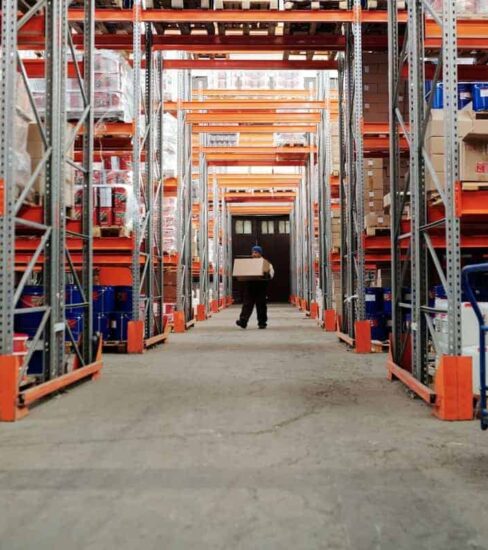If you are a distributor, retailer, or manufacturer, efficient warehouse inventory management is paramount to a profitable business. In 2023, while warehouse management systems (WMS) will continue to help small and large organizations manage their warehouse networks, there are some clear trends you should keep an eye out for.
Sustainable and smart warehousing, simulation software programs, predictive analytics, and gamification will hugely impact managing your warehouse inventory this year.
This article helps you understand warehouse inventory management and how you can use it to manage your inventory efficiently.
What is Warehouse Inventory Management
Warehouse management is an essential component of inventory management. It helps you track incoming and outgoing products. It also gives you a clear overview of each item's location so that it can be tracked and shipped when needed. While inventory management takes multiple warehouses into account, a warehouse inventory management system has a narrower focus. It only addresses a specific storage facility and allows you to track that facility in real time.
In addition to controlling the outflow and inflow of your inventory, a warehouse inventory management system ensures that you have a precise record of currently stored items using advanced RFID and barcode scanning, real-time tracking and monitoring, and movement management.
Why is Inventory Management important for your business?
According to recent surveys from reputed sources, only 43% of small businesses track and monitor their inventory. These businesses usually need help forecasting problems and making informed estimations accurately. One of the reasons companies hesitate to use warehouse inventory management systems is the perceived complexity of the software. Modern ERP tools like Priority Retail ERP have mobile inventory management modules. This feature is essential as more than 73% of warehouses plan to use their mobile devices to manage inventories.
Here are some essential tips for managing your warehouse inventory efficiently.
Plan your inventory in advance.
Warehouses are dynamic and need constant surveillance and monitoring. A warehouse inventory management tool can help avoid a drop in warehouse performance metrics if stock is unavailable or in surplus by providing the information in advance.
It helps you identify which products need replenishment and when they will most likely be in demand.
Planning also helps avoid wastage and reduce energy dependence, ultimately enabling you to achieve your sustainability goals. Smart warehousing ensures that items are picked and moved in a manner that is the most energy-efficient.
Control your inventory efficiently.
Controlling your inventory and moving it as and when needed is necessary to manage your warehouse efficiently. A WMS solution helps you generate real-time reports and gain insights to facilitate data-driven decision-making, reorganize your floor plan, and optimize warehouse storage space usage.
An inventory management system can help organizations save money by implementing wave-picking and cross-docking techniques. While wave-picking enables you to identify advanced tracking methods, cross-docking helps identify new opportunities within the warehouse.
Optimize your stock
Two of the biggest problems that warehouse managers encounter are either stock unavailability or surplus.
A Warehouse Inventory Management System helps you to optimize your stock by enhancing the visibility of your inventory and avoiding delays and lags. For example, a WMS helps conveniently identify and place fast-selling products to move them quickly and provides predictive and prescriptive analytics to help you uncover hidden trends that enhance warehouse productivity.
Additionally, A modern warehouse management system ensures you gain real-time inventory visibility to help you reduce availability-related calls and emails.
Put automation and technology to good use.
The key to sustainable inventory management is using modern technology to track and monitor staff and employing automation tools, such as barcodes and RFID tags, to track fixed and moveable assets, units, and pallets,
A warehouse management system makes it easy by scanning usernames, dates, and times during all transactions. While this eliminates theft, it also opens up opportunities to reward hard-working and high-performing employees.
Priority's WMS is fully integrated into a robust ERP
Priority's WMS is integrated entirely with the Priority ERP system. It can be easily implemented and does not require additional interfaces. If you wish to implement it in a single isolated area of your warehouse, it is possible too. You can later implement it across your warehouse stage-by-stage. Some of the essential features of Priority's WMS are:
● Pick, Pack & Ship - This feature allows you to streamline your logistics process's picking, packing, and shipping stages. You can easily create shipping waves for customers and take orders based on delivery routes.
● Receiving and Put-away - The tool helps you identify accessible locations to put away received inventory from the dock. Deliveries can be checked against various shipping documents such as Goods Receiving Vouchers (GRV), Advanced Shipping Notices (ASN), etc.
● Replenishment waves - Our replenishment tool helps ensure you always have enough stock of fast-moving products in your warehouse. This ensures customers can feel satisfied when they try to place an order.
● Tracking and traceability - It is imperative to have access to real-time downstream and upstream traceability of serialized parts, goods that have arrived, and products that are to be delivered.
● Support for mobile devices - Your staff can scan RFID tags and barcodes using their mobile devices. In addition, they can receive real-time notifications of assigned tasks and ensure that everything works smoothly in the warehouse.
Contact us today to learn more about how Priority's WMS can help you manage your warehouse inventory and turbocharge your sales performance in 2023.


